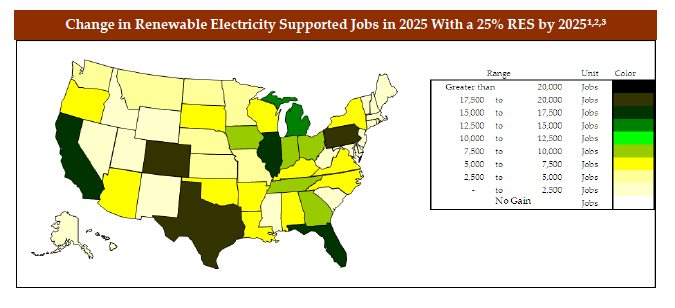
Image courtsey of Navigant Consulting/RES Alliance.
“Clean energy jobs” get a lot of lip-service these days. But just how many of them would be created if Congress actually passed legislation that would require states to draw power from renewables?
A new report from the RES Alliance, a group of renewable energy companies, finds that the number of jobs in the renewable energy sector “would more than double by 2025” if the United States puts in place a renewable electricity standard, often called an RES, that would mandate that states draw a certain percentage of power from renewable sources. A federal RES would create 274,000 additional jobs in the renewable electricity industry. But there’s a caveat — Congress would have to enact a 25 percent RES in order to create those jobs.
But even the House-passed climate and energy bill didn’t meet that goal. That bill requires 20 percent to come from renewables by 2020, but it would allow 5 percent of the requirement be met through efficiency measures rather than new renewable capacity. The House bill would also allows governors to petition for a weaker standard if they don’t believe their states can meet the target. It originally had a higher standard, but moderate Democrats on the Energy and Commerce Committee negotiated it down.
The Senate version currently in legislative purgatory sets the target even lower, requiring utilities to draw just 15 percent of their electricity from renewable sources or energy-efficiency measures by 2021. Up to a quarter of that can be met through efficiency.
The RES Alliance argues that the bill’s targets should be raised to 12 percent in 2014, 20 percent in 2020, and 25 percent in 2025, purely from renewables like wind, solar, and biomass. Clean-power advocates note that more ambitious near-term goals are particularly vital to boosting the industry and creating new jobs. The lower figures under consideration in Congress won’t generate many new jobs beyond the trajectory the industry is already on without a federal standard, they argue. Twenty-nine states and the District of Columbia already have an RES in place.
The study, conducted by Navigant Consulting, finds that every state in the country would see some job growth with a higher RES in place. Some states might gain under 2,500 jobs, but some could gain up to 20,000. Michigan, Ohio, Pennsylvania, Florida, California, Tennessee, Texas, and Colorado are expected to see the biggest growth in new jobs. Fifty-two percent of those jobs would be in manufacturing, 23 percent in construction and trades, and 11 percent in engineering and professional technical services, meaning it could create both blue collar jobs and jobs for college graduates with technical skills.













